A practical guide to bird watching in Sonoma County, California
(Unless otherwise indicated, all phone numbers are in the 707 area code)
A practical guide to bird watching in Sonoma County, California
(Unless otherwise indicated, all phone numbers are in the 707 area code)


Sonoma County Bird Finder and Species Notes
NON-PASSERINES
Also see PASSERINES, PELAGIC SPECIES, and INTRODUCED SPECIES
(See bottom of page for key to color coding and abbreviations)
DUCKS, GEESE, AND SWANS (Family Anatidae)
GEESE AND SWANS

•Brant: YR, but mostly Win, throughout Bodega Harbor, but often best seen from areas around Westside Park, Diekmann's Store, or Smith Brothers Road
•Cackling Goose: Mostly Win, Bodega Farm Pond, Shollenberger Park
•Mute Swan: YR, Ellis Creek Water Treatment Facility, Shollenberger Park
•Greater White-fronted Goose: Occasional winter flyovers, mostly in the Bodega Bay area and around Ellis Creek Water Treatment Facility
•Ross's Goose: SVAR, One resident bird at Lucchesi Park, sporadic winter sightings at Shollenberger Park, Bodega Bay. In 2012, another bird began hanging out at Roberts Lake Park and may have taken up residence there. (Pictured here)
•Snow Goose: SVAR, Occasional winter flyovers. Very occasionally seen at the Bodega Farm Pond, sporadic winter sightings at Shollenberger Park.
•Tundra Swan: SVAR, Has been seen very occasionally at Shollenberger Park and Ellis Creek Water Treatment Facility, typically a single bird that lingers during the winter months.
DUCKS

*Wood Duck: YR, Cassini Ranch Family Campground in Duncans Mills, Brush Creek Trail, Spring Lake, Doyle Park

•*Mallard: YR, Common on ponds, streams in much of the county. Spring Lake Lagoon, Lake Ralphine, Bodega Farm Pond, Laguna de Santa Rosa, Place to Play Park, Brush Creek Trail, Santa Rosa Creek
•*Northern Shoveler: Win, Shollenberger Park, Ellis Creek Water Treatment Facility
•American Wigeon: Win, Bodega Farm Pond, Doran Beach (entrance pond), Ellis Creek Water Treatment Facility, Shollenberger Park
•*Northern Pintail: Win, Shollenberger Park
•*Gadwall: YR, Ellis Creek Water Treatment Facility, Doran Beach (entrance pond), occasionally at Spring Lake and Lake Ralphine. (Pictured here)
•*Cinnamon Teal: YR (but mostly early spring) Ellis Creek Water Treatment Facility, Shollenberger Park
•Green-winged Teal: Win, Ellis Creek Water Treatment Facility, Shollenberger Park, Spring Lake sporadically
•Blue-winged Teal: YR, but uncommon, Shollenberger Park, Ellis Creek Water Treatment Facility
•Eurasian Wigeon: Win, Doran Beach (entrance pond), Ellis Creek Water Treatment Facility
Pochards (genus Aythya)
•Canvasback: Win, Bodega Farm Pond, Shollenberger Park, Ellis Creek Water Treatment Facility
•Greater Scaup: Win, Shollenberger Park, Ellis Creek Water Treatment Facility
•Lesser Scaup: Win, Shollenberger Park
•Ring-necked Duck: Win, Bodega Farm Pond, occasionally Lake Ralphine
•Redhead: SVAR, Has been seen at Bodega Farm Pond, Shollenberger Park
•Tufted Duck: SVAR, Has been seen at Shollenberger Park
Eiders
•Harlequin Duck: Win, Bodega Harbor, Bodega Head, Campbell Cove, but sporadic
•Long-tailed Duck: SVAR, Seen sporadically at Bodega Bay
Sea Ducks
•Bufflehead: Win, Jenner, Goat Rock, Spring Lake, Lake Ralphine, Bodega Farm Pond, North End Bodega Harbor, Hole in the Head, Doran Beach
•Common Goldeneye: Port Sonoma, Nagasawa Park, Spring Lake, Porto Bodega
•Surf Scoter: YR (esp. Win), North End Bodega Harbor, Campbell Cove, Smith Brothers Rd., Sonoma coast
•White-winged Scoter: Win, Bodega Harbor, Campbell Cove. Sporadic
•Black Scoter: Win, Bodega Harbor. Sporadic to rare
•Barrow's Goldeneye: Win, Port Sonoma, Bodega Harbor, but very uncommon
Mergansers
•*Common Merganser: YR (but especially Win), Lake Ralphine, Place to Play Park, Russian River, Austin Creek, Gualala River
•Red-breasted Merganser: Win, Doran Beach, Porto Bodega, North-end Bodega Harbor, Campbell Cove
•Hooded Merganser: Win, Nagasawa Park, sporadic on various freshwater ponds
Stiff-tailed Ducks
•*Ruddy Duck: Win, Bodega Harbor, Lake Ralphine, Spring Lake, Place to Play Park, Lucchesi Park

NEW WORLD QUAIL (Family Odontophoridae)

•*California Quail: YR, common throughout the county in brushy areas, woodland edges, and in suburbia, common feeder bird. Spring Lake, Annadel State Park. (Pictured here)
•*Mountain Quail: YR, but elusive. Wooded high-elevation locations, mostly in the eastern port of the county--Sugarloaf Ridge State Park, Pine Flat Rd., Ida Clayton Rd.

PARTRIDGES, GROUSE, TURKEYS and OLD WORLD QUAIL (Family Phasianidae)

•*Ring-necked Pheasant: YR, Reclamation Rd., open, grassy areas throughout the county
•*Sooty Grouse (formerly Blue Grouse): YR, but limited to the northwestern portion of the county in forested areas. King Ridge Rd., Rockpile Rd., Skaggs Spring Rd. (Pictured here)

LOONS (Family Gaviidae)

•Common Loon: YR, but mostly Win, Throughout Bodega Harbor, but especially North end of harbor, Campbell Cove, Porto Bodega, Tides Wharf. Also, off Bodega Head, Goat Rock, Jenner. (Pictured here)
•Pacific Loon: Win, Throughout Bodega Harbor, but especially Bodega Head. Also North End Bodega Harbor, Campbell Cove. Jenner, Duncan's Landing
•Red-throated Loon: Win, Jenner, Goat Rock, Duncan's Landing, North End Bodega Harbor, Doran Beach near channel jetties, Campbell Cove, Bodega Head, Goat Rock, Duncan's Landing, Porto Bodega
•Yellow-billed Loon: SVAR, seen sporadically within Bodega Harbor
•Arctic Loon: SVAR Seen at Bodega Bay in 1995 and 1999

GREBES (Family Podicipididae)

•*Pied-billed Grebe: YR, fairly common on freshwater lakes and ponds. Spring Lake, Lake Ralphine, Hole in the Head, Place to Play Park, Shollenberger Park, Ellis Creek Water Treatment Facility (Pictured here)
•Western Grebe: YR, Jenner, Goat Rock, throughout Bodega Harbor, but North End Bodega Harbor is a favorite hang-out, often with Clark's Grebe, allowing side-by-side comparisons of the two species, Campbell Cove, Bodega Head, Shollenberger Park, Port Sonoma
•Eared Grebe: Win, Common around Bodega Harbor, but especially North End Bodega Harbor, Campbell Cove, Bodega Head. Shollenberger Park, Occasionally seen at Spring Lake
•Horned Grebe: Win, Bodega Harbor generally, but North End Bodega Harbor, Campbell Cove, Bodega Head, Doran Beach. Shollenberger Park
•Clark's Grebe: YR, North End Bodega Harbor, often with Western Grebe, allowing comparisons. Bodega Head, Campbell Cove, Tides Wharf. Port Sonoma, Shollenberger Park
•Red-necked Grebe: Win, Jenner, Goat Rock, Duncan's Landing, Bodega Harbor generally, but especially Campbell Cove, Entrance to Bodega Harbor Channel, and near Bodega channel jetties at Doran Beach Park

CORMORANTS (Family Phalacrocoracidae)

•*Double-crested Cormorant: YR, Mouth of the Russian River, Spring Lake, Lake Ralphine, Place to Play Park, Laguna de Santa Rosa
•*Brandt's Cormorant: YR, Jenner, Goat Rock Beach, Duncan's Landing, Bodega Head
•*Pelagic Cormorant: YR, Jenner, Goat Rock Beach, Duncan's Landing, Bodega Head (Pictured here)

PELICANS (Family Pelecanidae)

•American White Pelican: Sum (and autumn), Bodega Bay Mud flats, esp. Gaffney Point, Place to Play Park
•Brown Pelican: YR, but mostly Sum and Autumn, North End Bodega Bay, Porto Bodega, Bodega Bay and coast areas generally. (Pictured here)

HERONS, BITTERNS, and ALLIES (Family Ardeidae)

•*Great Egret: YR, Common in appropriate habitat in most of the county, Ninth St. Rookery during nesting season, Spud Point Crab Co. during nesting season
•*Snowy Egret: YR, Lake Ralphine, Spring Lake, Nagasawa Park, Place to Play Park, Ninth St. Rookery during nesting season
•*Great Blue Heron: YR, Gaffney Point, Spring Lake, Lake Ralphine, Shollenberger Park
•*Black-crowned Night Heron: YR, Hole in the Head, Laguna de Santa Rosa, Lake Ralphine, Ninth St. Rookery during nesting season. (Pictured here)
•Green Heron: YR, Spring Lake, Lake Ralphine
•*Cattle Egret: Win, Ninth St. Rookery during nesting season
•American Bittern: YR, Spring Lake, Laguna de Santa Rosa, Shollenberger Park

IBISES and SPOONBILLS (Family Threskiornithidae)

•White-faced Ibis: SVAR.

BIRDS OF PREY
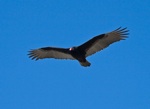
•*Turkey Vulture: YR Just look up. Common throughout the county.
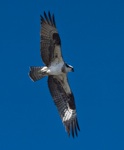
•*Osprey: YR, Spring Lake. Lake Ralphine, Gaffney Point, Over Bodega Harbor generally, Mouth of the Russian River, Lake Sonoma
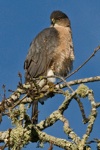
•*Red-tailed Hawk: YR, throughout most of the county, but numbers rise in winter, esp. along coast. Sugarloaf Ridge St. Park, Annadel St. Park, Bodega Head, Skaggs Island Rd. (south)
•*Red-shouldered Hawk: YR, Spring Lake, Place to Play Park, not uncommon in suburban settings
•*Northern Harrier: YR, but numbers rise in winter, esp. along coast. Bodega Head, Shollenberger Park, Ellis Creek Water Treatment Facility, Skaggs Island Rd. (south)
•*White-tailed Kite: YR, Shollenberger Park, Helen Putnam Regional Park, Pine Flat Rd., Skaggs Island Rd. (south), Ellis Creek Water Recycling Plant, Ragle Ranch Park
•*Cooper's Hawk: YR, but numbers rise in winter. Annadel State Park, Sugarloaf Ridge State Park, Spring Lake. (Pictured here)
•*Sharp-shinned Hawk: YR, but numbers rise in winter. Nagasawa Park, Annadel State Park, Sugarloaf Ridge State Park, Pine Flat Rd.
•Ferruginous Hawk: Win, but sporadic. Skaggs Island Rd. (south), Ramal Rd., Jenner
•*Golden Eagle: YR, but uncommon. Sugarloaf Ridge State Park, Pine Flat Rd., Ida Clayton Rd.
•Rough-legged Hawk: Win, but uncommon. Skaggs Island Rd. (south), Coleman Valley Rd.
•Bald Eagle: Mostly Win, uncommon--although numbers increasing. Has been seen at Laguna de Santa Rosa, Spring Lake, Lake Sonoma, mouth of the Russian River
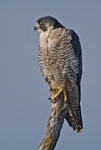
•*American Kestrel: YR, Annadel State Park, Sugarloaf Ridge State Park, Hood Mountain, Pine Flat Rd. Fairly common perched on wires throughout open areas of the county
•Merlin: YR, but numbers rise in winter. Annadel State Park, Sugarloaf Ridge State Park
•*Peregrine Falcon: YR, but numbers rise in winter. Doran Beach, Bodega Harbor, Bodega Head, Shollenberger Park, Ellis Creek Water Treatment Facility. (Pictured here)
•Prairie Falcon: Win, but uncommon. Has been sighted in the south part of the county and coastally

RAILS, GALLINULES and COOTS (Family Rallidae)
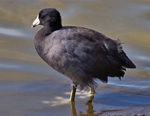
•*American Coot: YR (but especially winter), Spring Lake, Lake Ralphine, Ellis Creek Water Treatment Facility, Shollenberger Park, Nagasawa Park. (pictured here)
•*Common Gallinule (Moorhen): YR, Spring Lake, Lake Ralphine, Ellis Creek Water Treatment Facility, Nagasawa Park
•*Virginia Rail: YR, Shollenberger Park, Spring Lake, Bodega Rail Ponds
•**Sora: Mostly Win, Shollenberger Park, Spring Lake, Bodega Rail Ponds, Ellis Creek Water Treatment Facility, Laguna de Santa Rosa
•*Black Rail: YR, Has been seen in the Port Sonoma area and other south county wetlands
•*Clapper Rail: YR, Has been seen in the Port Sonoma area and other south county wetlands

CRANES (Family Gruidae)
CRANES
•Sandhill Crane: SVAR

SHOREBIRDS
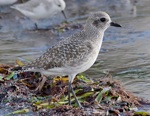
•*Killdeer: YR, Shollenberger Park, Ellis Creek Water Treatment Facility, Place to Play Park
•Black-bellied Plover: Win, spring, autumn, Porto Bodega, Shollenberger Park, Ellis Creek Water Treatment Facility. (Pictured here)
•Semipalmated Plover: Win, spring, autumn, Bodega Harbor, Porto Bodega, Doran Beach
•Pacific Golden Plover: Mostly autumn migration, sporadically overwinters, Shollenberger Park, Bodega Harbor, Doran Beach
•*Snowy Plover: Win, spring, autumn, Doran Beach, Salmon Creek Beach
•American Golden Plover: SVAR, autumn migration. Noted at Shollenberger Park
Family Haematopodidae (Oystercatchers)
•*Black Oystercatcher: YR, Bodega Head, Porto Bodega. Rocky coastal areas generally
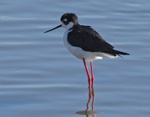
•*Black-necked Stilt: YR, Shollenberger Park, Place to Play Park, Skaggs Island Rd. (South), Bodega Harbor. (Pictured here)
•*American Avocet: Win, spring, autumn, Shollenberger Park, Hudeman Wetlands
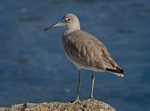
•Willet: Win, spring, autumn, Bodega Harbor, Tides Wharf, Smith Brothers Rd. Porto Bodega, Doran Beach, Port Sonoma, coastal areas generally. (Pictured here)
•Marbled Godwit: Win, spring, autumn, Bodega Harbor, Porto Bodega, Doran Beach, Port Sonoma, coastal areas generally
•Western Sandpiper: Win, spring, autumn, Bodega Harbor, Tides Wharf, Smith Brothers Rd. Porto Bodega, Doran Beach, coastal areas generally
•Least Sandpiper: Win, spring, autumn, Bodega Harbor, Tides Wharf, Smith Brothers Rd. Porto Bodega, Doran Beach, coastal areas generally
•Greater Yellowlegs: Win, spring, autumn, Shollenberger Park, Ellis Creek Water Treatment Facility, Place to Play Park, Laguna de Santa Rosa, Santa Rosa Creek at Willowside Rd.
•Long-billed Dowitcher: Win, spring, autumn, Shollenberger Park, Ellis Creek Water Treatment Facility, Place to Play Park
•Short-billed Dowitcher: Win, spring, autumn, Bodega Harbor, Gaffney Point. Coastal mud flats generally.
•Dunlin: Win, spring, autumn, Bodega Harbor, Gaffney Point. Coastal mud flats generally
•Sanderling: Win, spring, autumn, Bodega Harbor, Doran Beach, ocean beaches generally
•Black Turnstone: Win, spring, autumn, North End Bodega Harbor, Porto Bodega, Bodega Head
•Ruddy Turnstone: Win, spring, autumn, North End Bodega Harbor, Porto Bodega, Bodega Head
•Whimbrel: Win, spring and autumn migration, Bodega Harbor, Tides Wharf, Porto Bodega
•Long-billed Curlew: Win, spring, autumn, Shollenberger Park
•Wilson's Snipe: Win, Spring Lake, Ellis Creek Water Treatment Facility
•Red Phalarope: Spring, autumn migration (mostly latter), Bodega Harbor, Bodega Head, offshore coastal areas
•Red-necked Phalarope: Spring, autumn migration, mostly latter, Bodega Harbor, Bodega Head, offshore coastal areas
•*Wilson's Phalarope: Mostly autumn migration. Shollenberger Park, Ellis Creek Water Treatment Facility
•Lesser Yellowlegs: Mostly autumn, Shollenberger Park, Ellis Creek Water Treatment Facility
•*Spotted Sandpiper: YR, but mostly winter. Spring Lake, Lake Ralphine, streams and freshwater locations
•Surfbird: Win, Bodega Head
•Pectoral Sandpiper: Mostly autumn migration. Shows up from time to time at Shollenberger Park, Bodega Bay, Bodega Farm Pond, Carmody Rd. Pond
•Wandering Tattler: SVAR, Campbell Cove, Bodega Head, Doran Beach, Entrance to Bodega boat channel
•Red Knot: SVAR Bodega Harbor, Doran Beach
•Sharp-tailed Sandpiper: SVAR Seen at Shollenberger Park and Bodega Bay in 2011 and 2012, respectively

GULLS, TERNS, KITTIWAKES and SKIMMERS (Family Laridae)
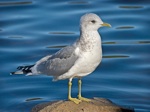
•*Western Gull: YR, Shollenberger Park, Lucchesi Park, The Tides Wharf, Porto Bodega, Campbell Cove, Doran Beach, throughout the Sonoma Coast
•Ring-billed Gull: YR, but especially winter, Shollenberger Park, Spring Lake, Lake Ralphine, Porto Bodega, Campbell Cove, Lucchesi Park
•California Gull: Mostly winter, Bodega Bay generally, Porto Bodega, Campbell Cove, Lucchesi Park, Lake Ralphine
•Elegant Tern: Sum, Bodega Bay generally, Porto Bodega
•Forster's Tern: Year-round, but mostly Autumn and Winter. Rare during June. Bodega Bay, South County coastal areas,
•Heermann's Gull: Summer and Autumn, Bodega Harbor generally, Porto Bodega, Doran Beach
•Mew Gull: Win, Porto Bodega, Bodega Harbor generally, Goat Rock Beach, Duncan's Landing and other coastal areas throughout the county. Occasionally appears at inland lakes. (Pictured here)
•Glaucous-winged Gull: Bodega Harbor, Bodega Head, Duncan's Landing, Campbell Cove, Lucchesi Park
•Herring Gull: Win, Coastal areas generally, Bodega Harbor
•Thayer's Gull: Win, Coastal areas generally, Duncan's Landing, Campbell Cove, Roberts Lake, Lake Ralphine
•Bonaparte's Gull: Win and during spring and fall migration, Bodega Head, Campbell Cove, Doran Beach, entrance to boat channel at Bodega Harbor
•Caspian Tern: Sum, Bodega Bay, Jenner/mouth of the Russian River
•Black-legged Kittiwake: Win, Bodega Head, Duncan's Landing, north county coastal areas--generally offshore
•Glaucous Gull: Win, Bodgea Head, Jenner, Duncan's Landing
•Common Tern: Mostly autumn, Has been noted at Bodega Harbor, Gaffney Point, Porto Bodega
•Arctic Tern: Mostly offshore during spring and fall migrations, but has been seen in Bodega Harbor, Doran Beach
A comparison of common gull heads in breeding and non-breeding plumages

PIGEONS AND DOVES (Family Colombidae)

•*Pigeon (Rock Dove): YR, The ubiquitous city pigeon.
•*Mourning Dove: YR, common throughout the county. Regular visitor at feeders. (Pictured here)
•*Band-tailed Pigeon: YR, Bodega Harbor, Channel Dr., Pine Flat Rd., Cavedale Rd., Spring Lake, Arroyo Sierra Dr.
•Eurasian Collared-Dove: YR, increasingly widespread, but sporadic. Numbers growing, beginning to push out the native Mourning Dove in some locations. Reliably present at parking lot of the Sebastopol Community Center, near entrance to Laguna de Santa Rosa trails, Morris St., Sebastopol

OWLS
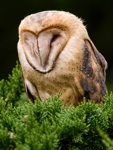
Family Tytonidae (Barn Owls)
•*Barn Owl: YR, Most common in south and west county in open areas where farm ad other buildings provide shelter (Pictured here)
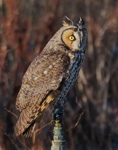
•*Great Horned Owl: YR, widespread. Has nested at Spring Lake
•*Western Screech Owl: YR, common in inland oak woods.
•*Northern Pygmy Owl: YR, Sugarloaf Ridge State Park, Pine Flat Rd., Ida Clayton Rd., Armstrong Woods.
•*Northern Saw-whet Owl: YR
•*Spotted Owl: YR, uses evergreen and deciduous forested areas of of the county.
•Short-eared Owl: Win, Has been seen at Shollenberger Park, Reclamation Rd., Ramal Rd., Skaggs Island Rd. (south)
•Long-eared Owl: Win, but rare and sporadic. Lone birds have been seen at Pine Flat Rd., Annadel State Park, Campbell Cove. (Pictured here)
•*Burrowing Owl: Win, but scarce. Heavily predated. Considered endangered.

GOATSUCKERS (Family Caprimulgidae)
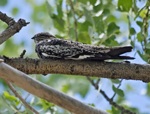
•*Common Poorwill: Mostly Sum. Restricted to higher elevations of inland mountains. Heard at Ida Clayton Rd., Pine Flat Rd., Cavedale Rd., Sugarloaf Ridge State Park, Hood Mountain
•*Common Nighthawk: Sum, but rare. Has been recorded only a few times, mostly at sights near the northwest corner of the county, near the coast. (Pictured here)

SWIFTS (Family Apodidae)
SWIFTS
•*Vaux's Swift: Rio Lindo Academy, Healdsburg during migration
•*White-throated Swift: YR, but infrequent in Win, Ida Clayton Rd., Goat Rock

HUMMINGBIRDS (Family Trochilidae)
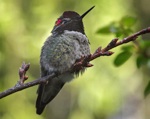
•*Anna's Hummingbird: YR, our most common hummingbird, and among the most common bird species in the county. Spring Lake, Lake Ralphine, Annadel State Park, Sugarloaf Ridge State Park, Ragel Ranch Park, Channel Dr., Melita Rd. (Pictured here)
•*Allen's Hummingbird: Mostly Spring and Sum. Most common near the coast. Often confused with Rufous Hummingbird, which is less common.
•Rufous Hummingbird: Very occasionally seen during Spring migration. Often confused with Allen's Hummingbird, particularly females, which are virtually indistinguishable

KINGFISHERS (Family Alcedinidae)
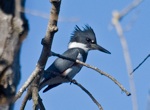
•*Belted Kingfisher: YR, Porto Bodega, Arroyo Sierra Dr., Brush Creek Trail, Spring Lake, Lake Ralphine

WOODPECKERS (Family Picidae)
WOODPECKERS
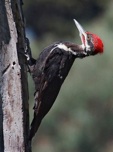
•*Downy Woodpecker: YR, throughout the wooded areas of the county, suburban areas, feeder visitor. Spring Lake, Lake Ralphine, Arroyo Sierra Dr., Annadel State Park, Sugarloaf Ridge State Park
•*Nuttall's Woodpecker: YR, throughout the wooded areas of the county, including suburban areas, parks. Feeder visitor. Spring Lake, Lake Ralphine, Arroyo Sierra Dr., Annadel State Park, Sugarloaf Ridge State Park, etc.
•*Northern Flicker: YR, but more common in Winter. Seen throughout the wooded areas of the county. Spring Lake, Lake Ralphine, Arroyo Sierra Dr., Annadel State Park, Sugarloaf Ridge State Park, etc.
•*Hairy Woodpecker: YR, becoming more common inWinter. Throughout the wooded areas of the county. Lake Ralphine, Spring Lake, Sugarloaf Ridge State Park
•*Red-breasted Sapsucker: YR, Spring Lake, Arroyo Sierra Dr.
•*Pileated Woodpecker: YR, Annadel State Park, Spring Lake, Sugarloaf Ridge State Park, Pine Flat Rd.
•Lewis's Woodpecker: Win, Spring, Autumn, but elusive and rarely reported. Present in 2012 at Ragle Ranch Park, 2014-2015 in Petaluma and elsewhere
•Red-naped Sapsucker: Rare vagrant. A Red-naped x Red-breasted Sapsucker hybrid was present at Spring Lake for much of late 2012/early 2013
•Williamson’s Sapsucker: Very rare stray. A female was pesent in the winter of 204-2015 at the Flamingo Hotel in Santa Rosa.
KEY
•Abundance: (Color coded to make it clear at a glance which birds are most common)
Common (Permanent resident or abundant seasonally)
Less common (usually present, or present in season, but not abundant)
Unusual (migrants present seasonally, but only for a short period or in small numbers; or birds that may be confined to a limited habitat)
Uncommon or Rare (One or only a few accepted county sightings, or birds that are noted only once or twice yearly).
Birds are listed in rough order of abundance within their groups.
•Seasonality: Winter (Win); Spring; Summer (Sum); Autumn; Year-round (YR); Sporadic, Vagrant, Accidental, or Rare (SVAR). Intended as a rough guide only--many "summer" birds, for example, arrive in early spring and leave in late autumn, and some may overwinter.
•Locations given are some of the most likely places to find each bird in the county (not exhaustive, and, obviously, birds will be found in places not listed here. Again, intended as a rough guide.)
*Birds marked with an asterisk are birds known to breed in Sonoma County, according to Sonoma County Breeding Bird Atlas (Betty Burridge, Ed., Madrone Audubon Society, 1995)
**Sora confirmed as a county breeder for the first time, in spring 2011
Also see PASSERINES, PELAGIC SPECIES, and INTRODUCED SPECIES
© Colin Talcroft, 2009-2021
Unless noted, all photos by the author. If you would like to use one of my images, please ask for permission for
non-commercial use with proper credit or commercial use with proper compensation.